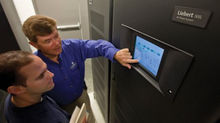Line of Sight in the Control Room
Over the past two months we have been speaking about the immediate and future related errors in Control Room design and how they affect daily operations. A Control Room is arguably the most crucial component to an organization operating a Mission Critical environment. Therefore, we have been striving to open a dialogue around the defects in Control Room Design as a platform to alleviate such errors.
We have identified numerous mistakes in Command Center design, but a Poor Line of Sight could top them all. How can we expect our operators to attentively and effectively monitor their environment without a clear line of sight?
In any case, the first step to resolving any problem is acknowledging there is one. In this segment, we will highlight the potential risks presented to Control Rooms that disregard proper sightlines.

Why Poor Line of Sight is Disastrous for Control Room Operations
As mentioned in a previous post, there are immediate and future related threats in Control Rooms with inadequate sight lines. Potentially the most vital component to Control Room Design, is the line of sight between the operators and the systems they are monitoring. One way to define a control room would be “a room serving as a central space where a large physical facility or physically dispersed service can be monitored and controlled.” It should also be noted the main purpose of the control room will vary from industry to industry. Whether that means preventing security risks/threats for employees in the field, or monitoring a global connected network. Across industries the core functionality differs from organization to organization. However, the common ground lies with the necessity to monitor critical systems monitored 24/7.
Imagine the control room as the heart and lifeblood of a facility. If there is a clot within any of the arteries, the transmission of blood flow and oxygen will be prevented causing vital organs to fail. The same can be said for a control room. If any one component goes down, the whole operation feels the effect. With such importance being placed on catching hazardous information in real time, sight lines must be at the forefront of every design with the most critical systems in plain view. Situations where alarms, systems, and risks are not in plain sight can drastically increase the probability of missing a threat or critical information. It may not seem like an issue to professionals outside of the industry, but an operator knows how critical even one second of missed action can be.
Sight Lines

In the past, sightline studies were conducted assuming an operator would sit tall the entire duration of their shift. Realistically, no one would sit in such an uncomfortable position, especially when shifts consists of 8-12 hour intervals. Because we have a better understanding of ergonomics, and the realistic habits of operators, new standards have been released based on how operators actually work at their console. The latest study shows an operator sitting relaxed with their heads tilted forward at 8-15 degrees and a viewing angle of 30-35 degrees. This is just one factor that needs to be taken into account when identifying proper sight lines at the workstation itself.
We must also understand how the distance between the operator and AV Walls factors into line of sight. If an operator cannot clearly read crucial information projected on the monitor wall, how can they expect to react at a moment’s notice. This goes back to a situation we mentioned in a previous post about lighting. “Imagine a scenario where sunlight coming into the Control Room was not taken into consideration during the design process. Well, in one scenario the sunlight made an “8” look like a “0” on the overhead screen and caused the operator to assume a tank had not yet begun filling, when in actuality it was almost full.” This was a real life example we have seen in the past. Fortunately, it was able to be resolved without serious consequence to the company, but imagine a more serious scenario that could potentially put lives at risk. Similar situations can occur when crucial information is unclear or blocked, instead of being in plain sight.
Future Related Risks to Poor Sight Lines
The more overlooked risk to a poor line of sight, is the future related effects. I am referring to fatigue and strain of the neck and eyes. Although this may be a complete afterthought and can go unnoticed, it is a very real risk that needs to be accounted for. When monitors and AV walls are not positioned in the correct line of sight, an operator can cause strain to the neck and eyes from constant positioning and repositioning while monitoring their systems. As this is not an ergonomically friendly design, it can cause a slow and continuous fatigue over time. Consequentially this can lead to fatigue related errors where the operator is significantly less efficient. As constant neck/eye strain becomes a real problem, the likelihood of the operator misinterpreting or missing crucial information altogether increases. Ultimately this puts the team in jeopardy and degrades the safety of the entire operation at a rate that is hard to detect. Because fatigue related errors are hard to detect, nor do they appear continuously, they can be remarkably dangerous.

Both of the items discussed here are very real risks that must be taken into consideration during the design process. They must also be continuously supervised over time.
Conclusion
Taking on a project of this nature is extremely time consuming and can require a full time commitment all in itself. We have partnered with numerous companies with expertise in this area and are always happy to make recommendations. Whether the project is starting from scratch, or a control room simply needs review, there are numerous companies around the nation who are happy to assist.
We will continue to highlight common errors in control room design and best practices to resolve them. Should you ever have questions you would like answered, reach out to Corey Wilson at Cwilson@LegacyDenver.com, or you can visit our Website! We are always happy to help.







